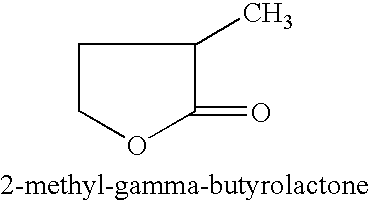Manufacture of 3-methyl-tetrahydrofuran from 2-methyl-gamma-butyrolactone
a technology of gammabutyrolactone and trimethyltetrahydrofuran, which is applied in the direction of organic chemistry, etc., can solve the problems of high cost and energy consumption of separation steps, and achieve the effects of enhancing the physical or chemical function of a catalys
- Summary
- Abstract
- Description
- Claims
- Application Information
AI Technical Summary
Benefits of technology
Problems solved by technology
Method used
Image
Examples
examples 1-64
Reduction of 2-methyl-gamma-butyrolactone to 3-methyl-tetrahydrofuran
50% 2-methyl-gamma-butyrolactone in dioxane (970.0 mg, 4.84 mmole) and an amount of catalyst and support as indicated in Table 1, were added to a 2 ml reactor. The reactor was sealed and charged with 6.89 MPa of H.sub.2, and heated to 225.degree. C. then cooled rapidly. The reaction was stopped after 4 hours. An internal standard (2-methoxy ethyl ether) was added to the reaction mixture and GC analysis was performed on a HP-6890 GC with a Chrompack column (CP-WAX 58, 25 M.times.0.25 MM). An acid promoter was not used for examples 1-33. An acid promoter was used for examples 34-66.
PUM
| Property | Measurement | Unit |
|---|---|---|
| temperature | aaaaa | aaaaa |
| pressure | aaaaa | aaaaa |
| temperature | aaaaa | aaaaa |
Abstract
Description
Claims
Application Information
 Login to View More
Login to View More - R&D
- Intellectual Property
- Life Sciences
- Materials
- Tech Scout
- Unparalleled Data Quality
- Higher Quality Content
- 60% Fewer Hallucinations
Browse by: Latest US Patents, China's latest patents, Technical Efficacy Thesaurus, Application Domain, Technology Topic, Popular Technical Reports.
© 2025 PatSnap. All rights reserved.Legal|Privacy policy|Modern Slavery Act Transparency Statement|Sitemap|About US| Contact US: help@patsnap.com



